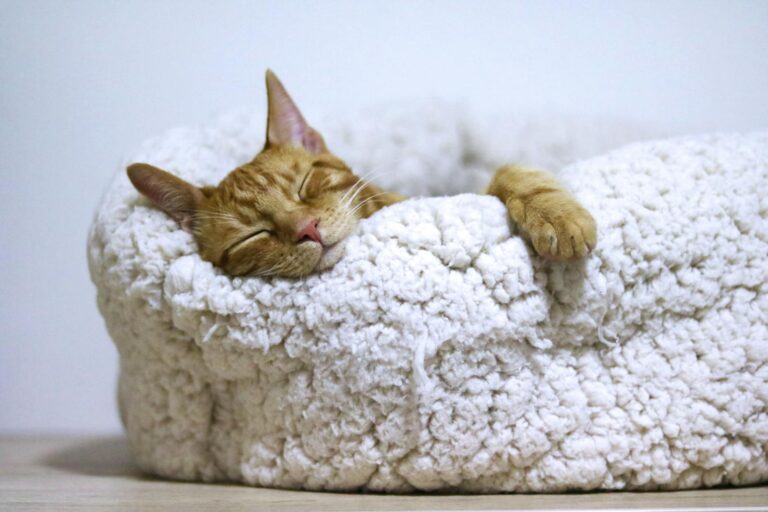Unlocking the Secrets of Feline Communication – How to Decode Your Cat’s Body Language
Understanding your cat can often feel like deciphering an ancient code. Each flick of their tail, blink of their eye, and purr holds meaning, creating a complex language unique to each feline. If you’ve ever wondered how to decode your cat’s body language and interpret their feelings, you’re in the right place. This article will guide you through the intricate world of feline communication, helping you understand what your furry friend is trying to tell you.
Understanding Feline Communication: An Introduction to Decoding Cat Body Language
Cats communicate primarily through body language, a nuanced system that allows them to convey emotions, intentions, and desires. Unlike dogs, who may bark or whine to express themselves, cats rely heavily on posture, tail movements, ear positions, and eye contact. This silent but expressive form of communication can provide insight into your cat’s thoughts and feelings.
Understanding your cat’s body language requires keen observation and careful interpretation. While many behaviors may seem random, they often reflect underlying emotions or instincts. By learning to interpret these signals, you can foster a stronger relationship with your cat and provide them with the care they need.
In this section, we will explore the fundamental aspects of feline communication, offering you the first steps in understanding your cat’s unique personality and emotional state.
The Importance of Non-Verbal Cues
Felines are masters of subtlety.
- Their communication is largely non-verbal, relying on physical cues rather than vocalizations.
- Cats are instinctively programmed to be both prey and predator, which influences their communication style.
- Observing your cat’s body language can help you identify their comfort levels, social needs, and potential stressors.
Being aware of these non-verbal cues can significantly improve your interactions with your cat, enabling you to respond more effectively to their needs.
The Role of Context in Understanding Behavior
Context is crucial when interpreting your cat’s body language.
- A cat might exhibit different behaviors when playing versus when feeling threatened.
- Understanding the environment surrounding your cat can aid in deciphering their mood.
- Consider factors such as time of day, presence of other pets, and even changes in household routines.
By taking context into account, you can better understand why your cat behaves the way they do in various situations.
Engaging with Your Cat’s Communication Style
Learning how to decode your cat’s body language is not just about observation; it also involves active engagement.
- Spend time watching your cat interact with their environment and other animals.
- Use your own body language to create a dialogue—slow blinks, gentle movements, and calm postures can help establish trust.
- Be patient; developing an understanding of your cat’s unique communication style takes time.
Ultimately, this engagement fosters a deeper bond between you and your feline companion.
The Language of the Tail: Interpreting Your Cat’s Tail Positions and Movements
The tail is one of the most expressive parts of a cat’s body, serving as a barometer for their emotions. From the slightest twitch to an exuberant swish, the position and movement of a cat’s tail can reveal a wealth of information about their mood and intentions.
The Tail Held High: Confidence and Contentment
When a cat walks around with its tail held high, it’s a clear sign of confidence and happiness.
- A raised tail indicates that your cat feels secure and content in their environment.
- This posture often accompanies friendly behavior, inviting interaction and play.
If your cat greets you at the door with their tail proudly erect, consider it a warm welcome!
The Tail Tucked Between the Legs: Fear or Submission
Conversely, a tail tucked tightly against the body indicates fear or submission.
- This behavior can occur in response to stressful situations, unfamiliar environments, or confrontations with other animals.
- It’s essential to recognize this body language so that you can provide comfort and reassurance to your cat during these moments.
Approaching your cat calmly and soothingly can help alleviate their anxiety and restore their sense of security.
Aggressive Tail Movements: Warning Signs
Cats may display aggressive tail movements as a warning.
- A rapidly swishing or puffed-up tail indicates agitation and irritation. It’s best to give your cat space when you observe these behaviors.
- These signs often precede hissing or swatting, so it’s vital to respect their boundaries.
Recognizing these signals not only protects you but also helps minimize stress for your cat.
Ear Positions and Eye Contact: Unveiling Your Cat’s Mood Through Facial Cues
Ears and eyes are powerful tools in a cat’s communication repertoire. The positions of their ears combined with their eye contact can provide valuable insights into their emotional state.
Ears Forward: Curiosity and Interest
When your cat has their ears perked up and facing forward, they are likely curious and engaged.
- This position shows that they are actively exploring their surroundings.
- You may notice this behavior when your cat is investigating a new toy or observing birds outside the window.
Encouraging curiosity with interactive toys can lead to stimulating play sessions that benefit both you and your cat.
Ears Back or Flat: Distress or Aggression
On the other hand, when a cat flattens their ears against their head, it signals distress or aggression.
- This posture usually indicates that your cat feels threatened or is preparing to defend itself.
- Pay attention to other cues, such as hissing or growling, which accompany this behavior.
Creating a safe space where your cat can retreat during stressful times is crucial for their well-being.
Eye Contact: The Slow Blink of Affection
Eye contact plays a significant role in building trust between you and your cat.
- A slow blink from your cat is akin to a feline kiss, showing affection and relaxation.
- Responding with your own slow blink can enhance this bond, conveying that you are a trusted companion.
Engaging in this eye contact ritual reinforces your connection and helps your cat feel loved.
Vocalization and Posture: How Sounds and Body Stance Reflect Feline Feelings
While cats predominantly communicate through body language, their vocalizations and stance add another layer to their communication toolkit. Different sounds can convey varying emotions, while posture provides additional context.
Vocalizations: Understanding the Sound Spectrum
Cats use a range of vocalizations to communicate, including meows, purrs, and growls.
- A soft, gentle meow often signifies a request for attention or food.
- Conversely, yowling can indicate discomfort or frustration.
Paying close attention to the pitch and tone of their vocalizations can provide clues to their emotional state.
Posture: The Foundation of Feline Emotion
Your cat’s overall posture gives you crucial insights into how they feel.
- An arched back and puffed fur typically signal fear or aggression, indicating that the cat is trying to appear larger than they are.
- In contrast, a relaxed body stance with legs tucked beneath them indicates comfort and tranquility.
Understanding these postures can help you gauge your cat’s emotional landscape and respond appropriately.
The Role of Comfort in Communication
Comfort plays a key role in how a cat expresses themselves.
- Remember that a cat may vocalize more when they feel secure and safe within their environment.
- Providing cozy spaces, scratching posts, and safe hiding spots can encourage your cat to express themselves freely.
By establishing a comforting atmosphere, you pave the way for more open communication with your feline companion.
Common Cat Behaviors Explained: From Kneading to Slow Blinking
Cats exhibit a wide range of behaviors that can sometimes leave owners puzzled. Understanding these common actions can deepen your connection with your pet and enhance your interactions.
Kneading: A Comforting Instinct
Kneading, the act of pushing their paws alternately against a soft surface, is a behavior often seen in adult cats.
- This action originates from kittenhood when they kneaded their mother’s belly to stimulate milk flow.
- Adult cats continue this behavior as a way to express comfort and contentment.
Encouraging kneading by providing soft blankets can create a comforting environment for your cat.
Slow Blinking: The Sign of Trust
As mentioned earlier, slow blinking is a powerful message of love and trust.
- When a cat slowly blinks at you, they are signaling that they feel safe in your presence.
- This gesture can also be reciprocated to strengthen your bond.
Engaging in this simple act of connection can foster a nurturing relationship.
Grooming: A Social Behavior
Grooming is another common behavior that serves multiple purposes.
- Cats groom themselves to maintain hygiene, but they also groom each other to strengthen social bonds.
- If your cat attempts to groom you, it’s a strong sign of affection and trust.
Participating in light grooming activities or brushing can further enhance your relationship.
Building a Stronger Bond: Using Knowledge of Body Language to Enhance Your Relationship with Your Cat
Decoding your cat’s body language is not merely an academic exercise; it has practical applications that can enhance your relationship with your feline companion.
Creating an Inviting Environment
Understanding your cat’s communication styles enables you to create a more inviting and accommodating environment.
- Provide plenty of hiding spots, vertical spaces, and cozy corners where your cat feels secure.
- Regularly change toys and engage in interactive play to keep their environment stimulating.
A well-rounded living space fosters positive communication and enriches your cat’s life.
Active Listening and Engagement
Building a relationship with your cat involves active listening and engagement.
- Observe their body language and vocalizations closely to understand their needs better.
- Respond to your cat’s cues with patience and empathy, recognizing when they want attention or alone time.
This engagement fosters trust and encourages open communication.
Training and Communication
Training your cat using positive reinforcement techniques can enhance your bond and communication.
- Incorporate short training sessions into your routine, rewarding desired behaviors with treats or praise.
- This approach not only encourages good behavior but also strengthens your relationship over time.
By enriching your cat’s life through training and engagement, you promote a happier, healthier relationship.
Conclusion
Deciphering your cat’s body language opens a window into their emotional world, enhancing your connection and understanding. By paying close attention to their tail movements, ear positions, vocalizations, and common behaviors, you’ll become adept at interpreting their feelings and responding appropriately. Building a strong bond with your feline friend relies on patience, observation, and engagement. Embrace the journey of understanding your cat, and you’ll find that the rewards of mutual trust and companionship are immeasurable.







